Inside: If your little one could explain what’s going on inside her toddler brain, this is what she’d tell you. Get ready because this peek inside the mind of a toddler will turn you into a bona fide toddler whisperer.
It’s a proven scientific fact that a toddler will engage you in approximately 57 billion power struggles every day. At least half of those power struggles will set off epic toddler tantrums.
And that’s just the power struggles.
That doesn’t even account for all the other instances of that special brand of toddler fun they bring to your day, like when they color on your carpet with a Sharpie, unlace all your shoelaces and re-tie them with 20 knots, or swallow a dime that gets stuck in their throat and requires a $25,000 surgery to remove. (Ask me how I know.)
Some days, parenting a toddler feels a bit like navigating a field of landmines, while balancing a tray of full champagne glasses on one hand and wearing boots three sizes too big…with your eyes closed.
Bonus: As a bonus for joining my weekly newsletter, download a free cheat sheet of 30 simple ways to connect with your toddler and ease power struggles.
What You Should Know About the Toddler Brain
This ain’t my first toddler rodeo – my third child is in the toddler phase right now. But we just welcomed a newborn into the family, so I’m more sleep-deprived than usual. Which means my patience for those typical toddler behaviors seems to be in even shorter supply lately.
So I decided to research the toddler brain and find out what’s developmentally appropriate for toddler behavior according to science. Maybe if I understood more about how my toddler’s brain worked, I wouldn’t get so frustrated with her.
And as I devoured toddler book after toddler book, I found myself wishing I’d known all the toddler parenting secrets before I became a parent – or at least one or two kids in, instead of on my third toddler.
Related: How to Deal With Toddler Tantrums Like an Expert {Printable}
 7 Things Your Toddler Wishes You Knew
7 Things Your Toddler Wishes You Knew
As it turns out, as frustrating as those typical toddler behaviors are, for the most part they’re 100 percent developmentally appropriate.
But in the moment of a power struggle, a boundary test, or any other typical toddler behavior, how do you keep that in perspective – and keep your sanity, too?
If your little one could explain what’s going on inside her toddler brain, this is what she’d tell you. Under each “What to do” section, you’ll find practical tips for how to take that understanding of the toddler brain and apply it to your daily life with a toddler in tow.
Get ready because this peek inside the mind of a toddler will turn you into a bona fide toddler whisperer.
Related: The Only Thing You Need to Survive the “Terrible Twos” – With Your Sanity Intact {Printable}
 1. Please tell me again.
1. Please tell me again.
When you say, “How many times do I have to tell you?” it seems like you’re annoyed with me. But I really do need you to tell me lots and lots of times.
Here’s why: Your ability to focus your attention, remember instructions, and control impulses comes from your executive function skills. But guess who doesn’t have those executive function skills yet? Your toddler.
Let’s picture the Grand Canyon. On one side is your toddler’s impulse to color on the walls simply because it’s fun. On the other side of the canyon is the ability to control that impulse because mom said you shouldn’t color on the walls, and you really would rather not see that look she gets on her face when you do something she told you not to.
In a toddler’s brain, these two sides aren’t yet connected. You have to build a bridge.
That first time you tell your toddler not to color on the walls, it’s like you’ve placed one long, rickety wooden board across the chasm. It wouldn’t bear any weight and it’s certainly not strong enough to hold up over time, but you have to start somewhere.
Each time you tell your toddler the same thing – or even better, show them – you add one more board to the bridge across the Grand Canyon in your toddler’s mind.
But building a bridge across the Grand Canyon would take a lot of wooden boards, not to mention some steel beams. And it would take lots and lots of time.
In the same way, it takes lots and lots of life experiences to create those connections in your toddler’s brain so they develop those important executive function skills.
“What molds our brain? Experience. Even into old age, our experiences actually change the physical structure of the brain. When we undergo an experience, our brain cells—called neurons—become active, or ‘fire.’ The brain has one hundred billion neurons, each with an average of ten thousand connections to other neurons. The ways in which particular circuits in the brain are activated determines the nature of our mental activity, ranging from perceiving sights or sounds to more abstract thought and reasoning. When neurons fire together, they grow new connections between them. Over time, the connections that result from firing lead to ‘rewiring’ in the brain.” – From The Whole-Brain Child
What to do: How many times do we have to tell our toddlers? The answer is over and over (and over) again. For a toddler brain to learn, they need that repetition. So keep reminding and comforting and guiding your toddler because every single experience is building that bridge.
When I find myself losing patience while telling my toddler the same thing one more time, I take a deep breath and try to picture the Grand Canyon. Then I imagine that my words are laying one more board across the chasm.
 2. I don’t know how to say what I need to say.
2. I don’t know how to say what I need to say.
I’m feeling big, scary feelings, and I don’t have the words to tell you how it feels. When the bad feelings overwhelm me, I can’t think straight.
Here’s why: Toddlers feel negative emotions just like adults do – they may feel angry, frustrated, sad, scared, anxious, confused, powerless, and so on.
As adults, we’ve learned that when you feel a negative emotion, it’s best to stop, think it through, and then carefully decide how to react. (Still, even after a lifetime of feeling those negative emotions, sometimes we still react without thinking – by lashing out or shutting down!)
But the part of the brain that’s capable of stopping, thinking, and deciding how to react isn’t fully developed in toddlers yet. And so when toddlers feel a negative emotion, that emotion takes over. This is one of the biggest reasons toddlers throw temper tantrums.
“Children can become shut down with shame, or lash out in anger, stuck in the experience of the negative emotion. Negative emotions are confusing at this age (as they can be at most ages), and our toddlers need our help to handle them…
For toddlers, who are just beginning to get their sea legs, these emotions are new, raw, exciting, and often very confusing! …The part of the brain that handles emotions and allows us to regulate them is just starting to form in the toddler, a process that will take another twenty years to complete. To say that handling these emotions for children ages two to five is hard is a major understatement.” – From How Toddlers Thrive
What to do: Your toddler needs your help to put words to her feelings. Labeling an emotion is one of the best ways to help someone feel heard so they can calm down and move forward, and toddlers are no different.
Here are a few examples of how to validate your toddler’s emotions:
“You are so mad. You’re showing me how much you wanted that piece of candy.” (Source) “I’m sorry you’re (state the emotion). When you calm down, I’ll give you a hug and we can talk about what happened.” (Source) Use reflection. For example, if he’s stomping his foot: “Your foot is going like this (stomp your foot). Your face looks like this (mirror his facial expression).” He’ll probably look at you, so take a deep breath. He might unconsciously take a deep breath with you. Then say: “You seem (state the emotion). You were wanting (state the desire).” (Source)
3. I can’t hear you right now.
I can tell you’re trying to help me feel better, but these big emotions are too much for me. I can’t understand what you’re trying to tell me.
Here’s why: Suppose your toddler is in the middle of a tantrum because you cut her PBJ in half when she wanted it whole. What happens if you push the two sandwich halves together and say, “Look, it’s the same sandwich, just in two pieces”?
It sure would be nice if your toddler would stop crying and say, “Oh, you’re right. Nevermind then.” But you’ve probably learned the hard way that you can’t reason with a toddler in the middle of a tantrum.
This is because her toddler brain just won’t compute what you’re trying to say:
“Your toddler becomes so angry that you poured water on his head to wash his hair that he begins screaming, throwing toys out of the tub, and wildly swinging his fists, trying to hit you. In this case, the lower parts of his brain—in particular his amygdala—take over and hijack his upstairs brain, [which is responsible for decision making, personal insight, empathy, and morality]…
In fact, the stress hormones flooding his little body mean that virtually no part of his higher brain is fully functioning. As a result, he’s literally incapable—momentarily, at least—of controlling his body or emotions, and of using all of those higher-order thinking skills, like considering consequences, solving problems, or considering others’ feelings. He’s flipped his lid.” – From The Whole-Brain Child
What to do: In the middle of a tantrum, don’t ask questions, don’t use logic, and don’t tell your toddler, “That’s not important.” In fact, the maybe-I-can-talk-some-sense-into-her approach will probably intensify the tantrum and make it last even longer because your toddler will not feel heard.
Focus on validating your child’s emotion first, then when everyone is calm you can tell the story of what happened and build those brain connections for the future. (See the examples in number 2 above for how to validate those big emotions.)
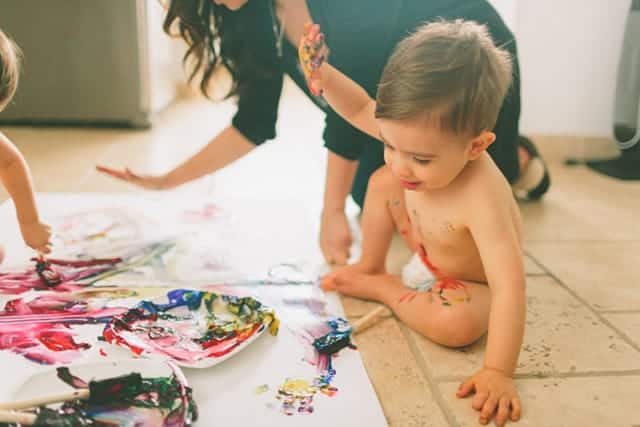 4. I’m not trying to be difficult.
4. I’m not trying to be difficult.
You seem frustrated with me right now, but I’m not trying to make you frustrated. I’m just trying to learn.
Here’s why: Does any of this sound familiar?
Your toddler wants to make her own cereal for breakfast, then ends up spilling milk all over the counter. Your toddler says he want to buckle his car seat himself, but it’s taking him forever and you needed to leave 10 minutes ago. He gets dressed by himself in short sleeves and shorts, but it’s 40 degrees outside and no matter how much you try to convince him, he won’t wear a coat or even a long-sleeved shirt. It’s bedtime, but she keeps asking question after question after question – when you just want to collapse in your own bed. It’s time to walk out the door to make a meeting for work, so you get your shoes from the closet only to realize that someone has unlaced all your shoelaces.
Sometimes it feels like your toddler is out to get you. But even though it feels that way, she isn’t purposely trying to make a mess, make you late, or keep you up all night.
Toddlers learn best through experience. And they need lots of life experiences to fully learn a lesson. (Remember the bridge from number 1 above?) For example, they may need to spill milk all over the counter a few times before they learn to pour it out slowly.
And unfortunately for us as the parents who would rather not clean half a quart of milk off the kitchen counter, there is no shortcut to learning. In order for our toddlers to learn, they have to make mistakes.
“This age group seems to be in perpetual motion. They are heedless explorers ready to take on the world without all the necessary skills yet in place. And that’s the way we want them to be—curious and adventurous! It is from this place that self-confidence and the ability to take initiative emerge. The challenge for us as parents is in giving children between ages two and five enough freedom to start making some of their own choices, so they can start making—and owning—their mistakes. What we see as mistakes, they take as part of the natural process of growing.
Sound difficult? It may be for you, but it’s not for them. Young children are not yet self-conscious or judgmental about their actions. They leap into activities and toward situations without thinking them through. They live in the moment. Jumping off the slide at full tilt? Building a beautiful sand castle just to destroy it? Wearing rain boots when it’s sunny outside? These may seem like illogical choices to us, but they make perfect sense to a toddler…Indeed, many of these choices make us parents very nervous. Our response? We tend to overcorrect and attempt to control them, which just makes them feel bad about themselves, which then results in shame.” – From How Toddlers Thrive
I don’t want to have to clean up an extra mess or be late for an appointment or re-lace my shoes every time I leave the house. But for my toddler to learn and grow, she has to figure things out through trial and error.
Another danger of trying to correct and control your toddler all the time is that your toddler ends up hearing “no” an awful lot throughout the day. She may feel like she can’t do anything right, and she may feel incredibly frustrated when she can’t do anything the way she wants to. And then when you need to say “no” to keep her safe, like if she’s unbuckling her car seat while you’re on the road, she’s much less likely to listen to you.
What to do: Pick your battles. If your toddler eats 3 peas instead of 20 or wants to leave the house wearing polka dots and plaid, it may not be worth it to turn it into a fight.
In those moments when I find myself feeling annoyed or exasperated at my toddler, I repeat a mantra to myself: “Let her learn. Let her learn.” That’s usually enough to remind me to let her make her own mistakes. But if I’m still tempted to overcorrect or control – or worse, step in and do the task myself – I’ll ask: “If I let her do it her way, what’s the worst that could happen?”
I’m not perfect, but this little habit has helped me back off and let my toddler try on her own way more often than I used to. As an added bonus, when you stop trying to control your toddler on those everyday tasks, you can step back from the situation and be ready to comfort your toddler if she gets frustrated during the learning process.
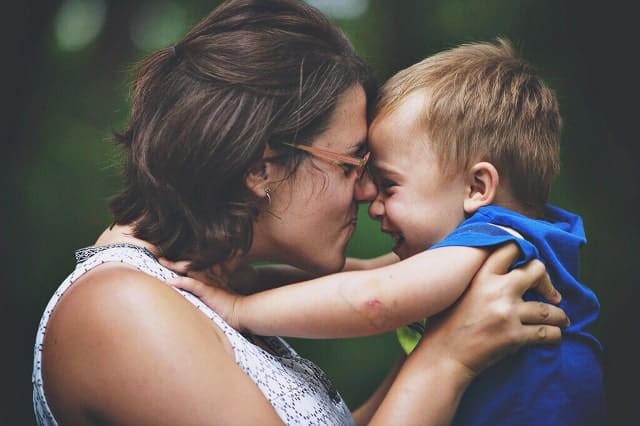 5. I need you to be kind and firm at the same time.
5. I need you to be kind and firm at the same time.
I like doing things myself, but I need you to keep me safe.
Here’s why: When your child enters toddlerhood, she learns that she is her own person, separate from you. This is when she discovers she has the power to act on her own separate ideas, opinions, and preferences.
For example, suppose you’re crossing the street and holding your toddler’s hand, then she pulls away and runs off to pick up a shiny coin off the ground. She’s exerting that newfound power, which is exactly what her toddler brain needs.
But it’s our job as parents to set boundaries on that power to keep our toddlers safe:
“Two to five is an age of testing out who they are and their level of power. It is too scary to think their power is unlimited. They want to know you will keep them safe (even if they battle you!). The world they are exploring during these years is a big place. There is much to learn, much to see, and so much to figure out…So much is going on and they cannot do it solely on their own. Children count on parents to set up limits and guidelines, to show them when to stop and let them know we will keep them safe. The feeling that they are not on their own, that we are setting limits, gives them security and feelings of comfort…Deep inside, they want to know that we will not let them go too far.” – From How Toddlers Thrive
Still, when you feel like your toddler has done something dangerous, it’s easy to lose your cool and say something like, “What on earth were you thinking? Never, ever do that again!”
From your toddler’s perspective, she made her own decision as her own person, and you got upset at her for making her own decision. Feelings of shame overwhelm her toddler brain, and she’s unable to learn anything from the experience. It’s a missed opportunity to build onto that bridge across the Grand Canyon (from number 1). If she experiences that shame on a regular basis, she may become anxious, defiant, or less confident.
What to do: Your toddler needs you to set limits when something is important, like running across the street or throwing her whole dinner plate on the floor.
To avoid overreacting and making your toddler feel shame for making her own decision, first try to connect with your toddler on why she made that decision. That way, you can let her know that there’s nothing wrong with how she felt, then you can set the limit.
Think, “kind first, then firm.” For example: “You were excited to see that shiny coin, and you wanted to grab it! But it’s my job to keep you safe, and running across the street can hurt your body. Next time, hold my hand tight when we cross the street, no matter what.”
 6. I’m not ignoring you.
6. I’m not ignoring you.
I’m just not sure what you want me to do.
Here’s why: Don’t think of an elephant right now. Whatever you do, don’t picture an elephant. You better not be thinking of an elephant.
So…are you thinking of an elephant? Because that’s 100 percent normal if you are, and your toddler is no different.
Suppose your toddler is running through the house while your infant is sleeping, so you say, “Don’t run!”
What sticks in your toddler’s mind is simply: Run. Saying “don’t run” puts the focus squarely on what you don’t want to happen. Pretty much the opposite effect of what you’re going for.
Plus, when you say “stop” or “don’t,” your toddler has to double-process your request. First, he has to understand what you don’t want him to do: don’t run. Then he has to translate that into what you do what him to do, which can be confusing for young kids.
What to do: Erase “don’t” and “stop” from your vocabulary with your toddler because they’re just setting you both up for frustration. Then reframe your statements to communicate to your toddler what you do want him to do.
Here are a few examples for you:
Instead of, “Stop banging your fork on the table.” Try, “Your fork goes in your mouth or on your plate. Can you pretend your fork is an airplane landing in your mouth?” Instead of, “Don’t run!” Try, “Please walk slowly. Let’s pretend we’re turtles!” Instead of, “Don’t color on the walls!” Try, “Markers are for paper only. Can you draw me a picture on this paper?” Instead of, “Don’t be rough with the baby!” Try, “Please use a gentle touch with the baby. It’s our job to keep the baby safe.” Instead of, “Don’t take that toy from your sister!” Try, “Your sister is having that right now. You can ask, ‘Can I have that when you’re done?’”
I’m usually pretty pumped if I can catch myself before a “don’t” slips out, but if you want to go above and beyond that to really make your toddler sit up and take notice, try adding a statement at the front to empathize with his emotions. For example, “You really wanted that toy right now! It looks like so much fun. But your sister is having that right now. You can ask, ‘Can I have that when you’re done?’”
 7. When I feel loved, I do better.
7. When I feel loved, I do better.
I’m happiest when we get some special time together every day. Then I want to do everything I can to make you happy with me.
Here’s why: When my toddler is being particularly uncooperative, the root cause every single time is the same thing.
For example…
I’ll be doing dishes, and she asks me to read her a book. “Later,” I promise. “I’m busy right now.” I’ll be paying bills on the computer, and she asks to play a game. “Not right now, honey,” I say. I’ll be putting the baby down for a nap, and right when he dozes off, she bangs the door wide open looking for me. “Go back out there!” I hiss.
Then the next time I ask her to do something (or not do something), she doesn’t listen. Sometimes, she’s outright defiant.
She’d told me exactly what she needed from me – a story, a game, my physical presence – and I brushed her off.
She needed connection. And when I didn’t give it to her, I paid the price in the form of less cooperation or none at all.
“Children freely, even enthusiastically, cooperate when they believe that we’re on their side. When they don’t have that belief deep in their bones, our standards of behavior seem unfair, contradicting what they perceive as their own best interests, whether that’s taking the biggest piece of cake or lying to us. No amount of “parenting skills” can make up for an eroded parent-child bond. It’s like riding a bike up a very steep hill. By contrast, parenting with a good relationship is like coasting downhill—you still have to pay attention and stay on the road, and twists and turns certainly arise, but the momentum is with you.” – From Peaceful Parent, Happy Kids
What to do: Science shows that in happy relationships, you need a ratio of five positive interactions to every one negative interaction. If you have too few positive interactions to balance out the negative ones, you’ll end up with an unhappy, unhealthy relationship.
To get more cooperation from your toddler, aim for five positive interactions to balance out every negative experience.
Below, you’ll find a printable with 30 ideas for how to connect with your toddler. Before you go, download the printable so you can hang it on your fridge to help you remember how to connect with your toddler and reap the benefits of more cooperation.
Download Your Free Cheat Sheet
Use this cheat sheet to help you bond with your toddler, especially after tough moments.
Download the free cheat sheet. Join my weekly-ish newsletter and as a bonus, you’ll get the printable! Just click here to download and subscribe. Print. Any paper will do the trick, but card stock would be ideal. Hang your cheat sheet somewhere handy like the fridge. You’ll actually get two versions of the cheat sheet, and you can use them a few different ways: For the one that looks like a bingo board on steroids, you can cut out each square and put them in a jar. Then when you need an idea for connecting with your toddler, pull out a random idea and do it. Or leave the whole thing intact and pretend you’re playing blackout bingo to see how many you can mark off over the course of a week. With the list version, you can use the sections to help you try out a variety of ideas. Personally, I tend to rely heavily on words of connection, and I forget the more physical acts of connection. This version of the cheat sheet helps me remember to mix it up.
Here’s a sneak peek of your printable cheat sheet – first the bingo version:
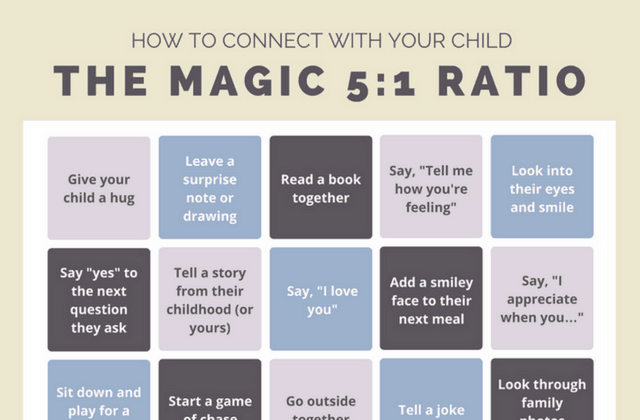
And here’s the list version:
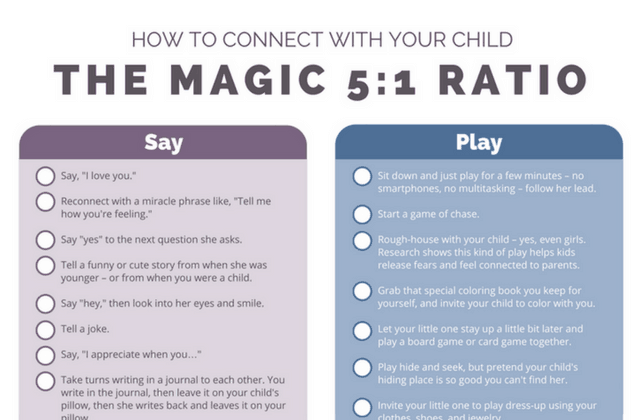
Download my FREE cheat sheet as a bonus for joining my newsletter: 16 Miracle Phrases to Help You Reconnect With Your Child Your Turn
What surprises you most about the toddler brain? Share in a comment below!
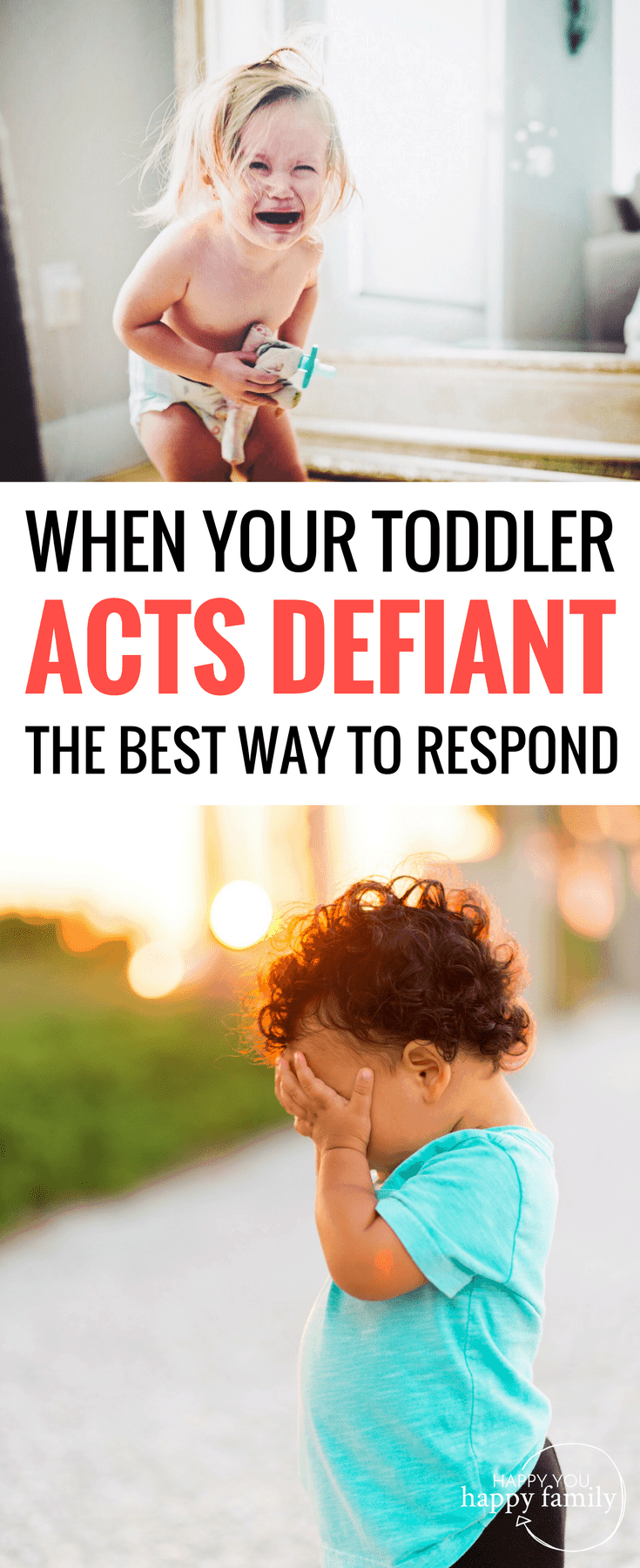 Author information
Author information![]() Kelly
Kelly
I’m a mom of four, a recovering perfectionist, and the author of Happy You, Happy Family. Parenting is hard enough without all the guilt we heap on top of ourselves. So let’s stop trying to be perfect parents and just be real ones. Sound good? Join my mailing list and as a bonus, you’ll get 25+ incredibly helpful cheat sheets that will ease your parenting struggles.
The post How to Be a Toddler Whisperer: 7 Things Your Toddler Wishes You Knew appeared first on Happy You, Happy Family.
3 products which can enhance your kid’s well being. As a mom you would know which is better for your kid.
My gratitude to the author of this article: happyyouhappyfamily.com
FREE e-book on how to make easy paper kite DIY project to have fun with your kids.


